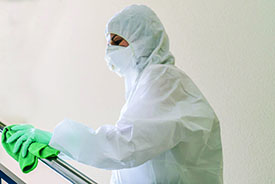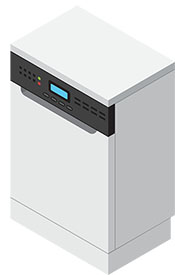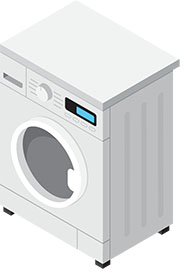The coronavirus pandemic has focused attention on deep cleaning, especially long-lasting hard surface cleaners. But other cleaning product research is also looking at using probiotics and reducing water and energy usage. Neil Eisberg reports
Hard surface cleaners, especially those with antibacterial and viral activity, are seeing a surge of interest as a result of the coronavirus pandemic. With research showing the estimated lifetimes of the virus on surfaces such as plastic, metal and cardboard, there is also a focus on cleaning products that stay active on surfaces.
According to US research, Covid-19 remains detectable for up to three hours in aerosols, up to four hours on copper, up to 24 hours on cardboard and up to two to three days on plastic and stainless steel. The researchers were from the University of California – Los Angeles and Princeton University, the US National Institutes of Health’s National Institute of Allergy and Infectious Diseases, and the Centers for Disease Control and Prevention.
Active agents that remain active on surfaces has been a topic of interest but not a major focus in recent years. The driver has been to reduce cleaning by repelling the deposition of soils. At the Cleaning Products USA conference in Bethesda, US, in October 2019, Eric Yezdimer, research and business development manager at Gelita USA, reported on the use of a long-lasting cleaning product that has been trialled on the railway system of Northern Germany. The main cleaning additive, Novotex CB800, is made from an all-natural biodegradable polymer that has high skin tolerance and is allergen-free. It forms a temporary hydrophilic protein layer on surfaces keeping them cleaner longer and making follow-up cleaning easier.
Results in trials of both interior and exterior train cleaning have shown a 30% reduction in washing time, up to a 90% reduction in freshwater consumption and 50% reduced overall costs. Yezdimer added that the protein film can last up to five washes, as each wash refreshes the layer, but an important variable is the temperature of the water. Another key benefit is the reduction in the need for other more aggressive cleaning ingredients.
So far the research has only been carried out on trains, but Yezdimer pointed out that the next step will be to look at household applications. He noted, however, that trains are cleaned the same way every time, so for household and also car care applications, there would be a need to look at how the polymer performs in different formulations and applications. He added that the protein stability ‘depends upon the conditions’ and that for any application it would be necessary to test for interactions with other ingredients in the formulations.
|
90% |
|
New company Ambrosia is using food waste to produce the ingredients in its first cleaning product, Veles, an all-purpose cleaner packed in a recyclable aluminium bottle. Ambrosia claims it extracts water as well as proteins, acids and ethanol and other raw materials from food waste to produce Veles. |
|
30m gal/yr |
|
2-3 |
|
24% |
|
49% |
From coatings to wraps
Taking this move towards film coatings a stage further, beyond just a chemical coating, researchers at McMaster University, Ontario, Canada, have developed a self-cleaning surface through the application of nano-scale surface engineering and chemistry, that can repel all forms of bacteria, suitable for applications from hospitals to kitchens. It takes the form of a treated version of conventional transparent wrap, which can be shrink-wrapped onto surface from door handles, railings and IV drip stands. In addition, it can also be used for food wrapping.
The surface of the wrap is textured with microscopic wrinkles that exclude all external molecules, similar to the action of the water repellent lotus leaf. ‘We’re structurally tuning that plastic,’ says Leyla Soleymani, an engineering physicist. The surface is also treated chemically to enhance its repellent properties (ACS Nano, doi: 10.1021/acsnano.9b06287 ).
Meanwhile, in the field of more conventional hard surface cleaners, alcohol ethoxylates have traditionally been the active ingredients of choice. At Cleaning Products USA, Stuart Holt, global technical marketing manager – cleaning surface chemistry at Nouryon, described his company’s latest vegetable-based narrow range ethoxylates, including Berol 360 and 366, which he said offer superior cleaning, environmental performance, low odour and desirable physical characteristics.
Holt emphasised that consumer demand has changed over recent years. The demands are no longer just focused on cost and performance but also now sustainability has been added, thereby driving the search for vegetable-based alternatives. He added that the new surfactants also offer better handling characteristics.
Floors represent a large sector in terms of hard surface cleaning, and as Scott Harrington, director of products at Avidbots, pointed out, pushing or riding a heavy duty floor-scrubbing machines around all night is a dull and difficult job – one that is hard to fill and keep filled. He believes that the way forward is to use floor-scrubbing robots, like the Avidbots Neo, which have sophisticated software, using machine learning and sensors to operate autonomously, along with web-based dashboards to enable facilities managers to monitor and review cleaning plans, set new plans and measure the effectiveness of the operation.
Closing the circle

As Weeks pointed out, an estimated 1.3bn t of food waste is created globally each year, containing 45 trillion gal of water, representing around 75% of the total waste. In the US alone, the amount of food waste is currently 120m t/year. Weeks also noted that some 30m gal/year of water is used if every US household uses two standard bottles of all-purpose cleaner each year. The bio-based Ambrosia is therefore extracting the water as well as proteins, acids and ethanol and other raw materials from food waste to produce its multi-purpose cleaner. The only non-food ingredient is the fragrance, which is supplied by IFF and based on natural lavender.
Another way to close the circle is to use the beneficial microbes already within our homes, as Clemens Heikaus, head of microbial cleaning at Novozymes, suggested, through the use of probiotics including specific collections of bacteria in cleaning products. He added that over 49% of Americans who do household cleaning are willing to try probiotic cleaners, and claimed that 89% of surface cleaner purchasers in the UK would be interested in such products. He also quoted a recent book: Never alone at home, by Rob Dunn, which proposes the so-called ‘re-wilding’ of our homes by working with the home’s microbiome.
Probiotic cleaning products are already on the market, like eMC from Multikraft in Austria and Counter Culture’s products based on probiotic technology developed by SCD Probiotics and include lactic acid bacteria cultures. Although Heikaus believes the market is ready for this new approach to cleaning, a key issue is the possibility of such products encouraging the proliferation of the wrong microbes, something he believes will have to be looked at carefully.
|
Washing machines and microfibres
Researcher Max Kelly said: ‘ Previous research has suggested that the speed the drum spins at, the number of times it changes spinning direction during a cycle and the length of pauses during the cycle – all known as machine agitation – is the most important factor in the amount of microfibre released. ‘But we have shown that even at reduced levels of agitation, microfibre release is still greatest with higher water-volume-to-fabric ratios. This is because the high volume of water used in a delicate cycle, which is supposed to protect sensitive clothing from damage, actually “plucks” away more fibres from the material.’ Meanwhile, research at the University of Leeds, UK, also in collaboration with scientists at Procter & Gamble, has revealed that both reducing the length of the washing cycle and the water temperature can extend the life of garments and also reduce the quantity of dye and microfibres that are shed into the waste water system, and also extend the life of garments. In a series of tests using both test washing loads and actual consumer loads, the researchers found that by comparing 16 cycles each of 30min at 25°C with 85min at 40°C, both with 1600rpm spins, the cooler cycles reduced microfibre release by up to 52% and dye release by up to 74%. Research by scientists at the University of Plymouth, UK, and the Institute for Polymers, Composites and Biomaterials of the National Research Council of Italy have built on earlier studies into microfibre release during washing to show that while up to 4000 fibres/g of polyester fabric could be released during washing, up to 400 fibres/g could be shed when the fabric is worn during just 20min of normal activity. Scaling these results up shows that one person could release up to 300m polyester fibres/year by washing the garments, and more than 900m just by wearing the garments (Environmental Science & Technology, doi: 10.1021/acs.est.9b06892). A key finding was that there were significant differences based on how the textiles and garments were manufactured. Francesca De Falco from the Italian institute said: ‘Textiles with a very compact woven structure, with highly twisted yarns and composed of continuous filaments release fewer microfibres to both water and air. Woven polyester garments released the least number of fibres, compared with polyester/cotton.’ Richard Thompson, head of Plymouth University’s International Marine Litter Research Unit, said: The key story here is that the emission of fibres while wearing clothes is likely of a similar order of magnitude as that from washing them. That constitutes a substantial and previously unquantified direct release to the environment. The results also show textile design can strongly influence both release to the air and release due to laundering; that is a crucial message highlighting the importance of sustainable design for the fashion industry. Indeed, many of the current issues associated with the environmental impacts of plastic items stem from a lack of holistic thinking at the design stage.’ |
Greener dishwashing

The two-basin method, in which dishes are washed in hot water and then rinsed in cold water, offers a two-third reduction in GHG emissions, compared with rinsing under running cold water. It was also shown that the elimination of pre-rinsing and deselecting the ‘heated dry’ setting on automatic dishwashers can significantly reduce emissions.
‘This is the first comprehensive life cycle assessment of manual and machine washing, and it provides useful guidance to households on how to improve the environmental performance of both methods,’ claimed Greg Keoleian, director of the Center for Sustainable Systems at Michigan University.
At Cleaning Products USA 2019, Annemarieke Van Heeswijk, global marketing manager – detergent enzymes at DuPont Nutrition & Biosciences, pointed out that certainly in North America, dishwasher manufacturers are looking to decrease cycle times to meet consumer demand while reducing their environmental impact. Since cleaning performance is a function of time, temperature, mechanical action and chemistry, the contribution made by the detergent must compensate for this reduction in cycle time. She pointed out that incorporating enzymes in detergent formulations can, as with laundry detergents, address this challenge.


 Washing machines and their impact on the environment due to the release of microfibres during the washing cycle have regularly hit the headlines, but 2019 research at the University of Newcastle has shown that the volume of water used during the wash cycle rather than the spinning action of the washing machine is the key factor in releasing microfibres from clothes. Working with Procter & Gamble in Newcastle, the researchers found that, on average, 800,000 more fibres were released during a ‘delicates’ wash cycle than a standard cycle (Environmental Science & Technology, doi: 10.1021/acs.est.9b03022).
Washing machines and their impact on the environment due to the release of microfibres during the washing cycle have regularly hit the headlines, but 2019 research at the University of Newcastle has shown that the volume of water used during the wash cycle rather than the spinning action of the washing machine is the key factor in releasing microfibres from clothes. Working with Procter & Gamble in Newcastle, the researchers found that, on average, 800,000 more fibres were released during a ‘delicates’ wash cycle than a standard cycle (Environmental Science & Technology, doi: 10.1021/acs.est.9b03022). 


